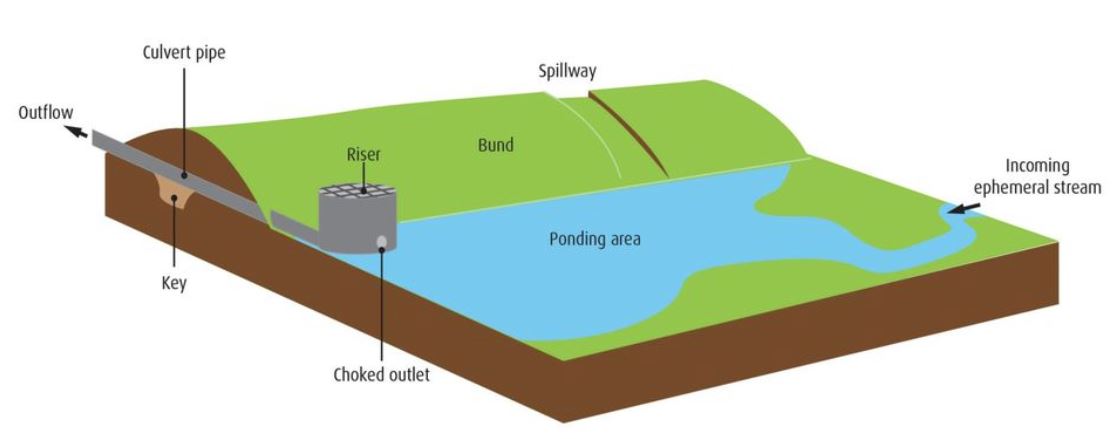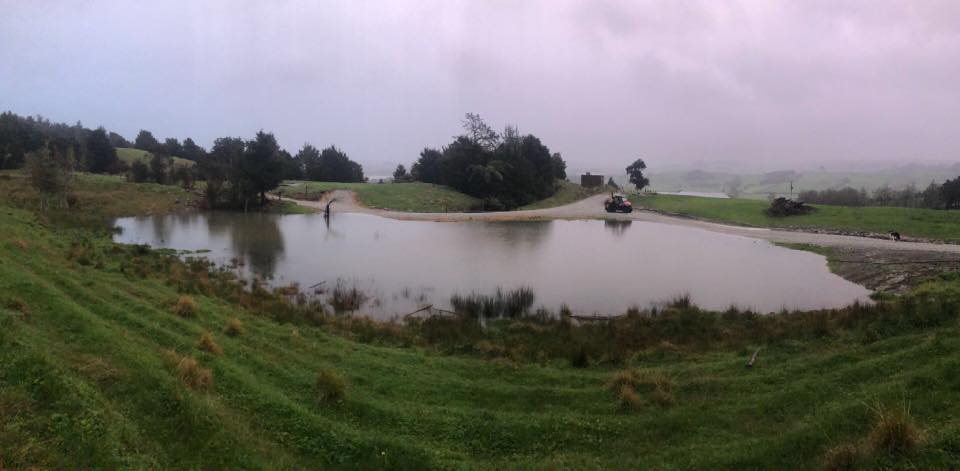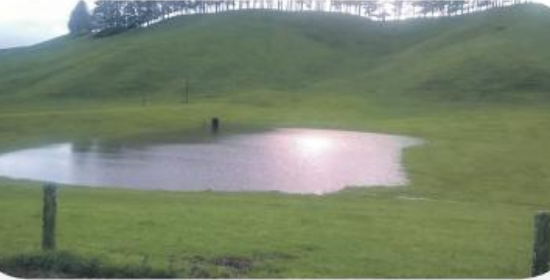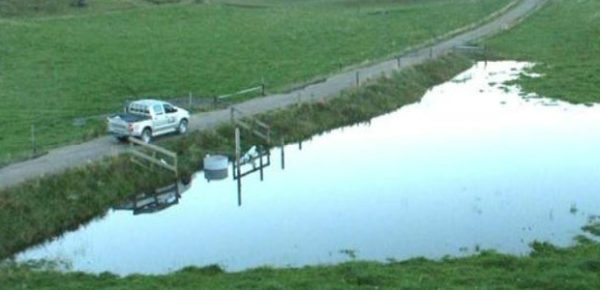Detention and Detainment bunds
What
A detainment bund is a low earthen mound built across a storm water flowpath. They can also be called detention, decanting, or earth bunds. They typically have an outlet culvert at the base and a vertical riser that allows water to be “skimmed” from the surface after the pond fills during heavy rain. Water builds up to the top of the riser and is allowed to stay put for up to three days before the small drain hole at the base of the riser is opened and water is allowed to flow out through the culvert under the bund. The three-day period allows the sediments to settle, while pasture can recover after up to three days’ immersion. The design also allows for an overflow spillway on the crest of the bund in case a storm overwhelms the ponding capacity of the bund. The optimal minimum pond size to catchment ratio is 120m3/hectare. Smaller scale structures allow water to infiltrate at the base of the bund without the need for a riser discharge system. It is important to scale any structure to peak runoff events to ensure appropriate retention area.
It is unclear how much dissolved phosphorus might leave the bund when drained, but one possibility to remove it before water is released could be to use a flocculant – probably polyacrylamide, which is also used to treat wastewater. As the detainment bund is used repeatedly, sediments and nutrients are likely to accumulate, but if this happens too fast, this could be saying something about environmental practices on the rest of the farm. A bund on a well-managed farm could last 50–100 years before any mining out is required. The material recovered would be a valuable resource in itself.
Wetlands and detainment bunds serve different functions but can be built in tandem to complement each other. Wetlands are good for removing nitrogen, but can’t cope with heavy sediment loadings flowing through, so if particles are retained by a detainment bund, the outflow could then safely run through a wetland to help remove N. A consideration when planning is that wetlands are expensive to build compared with detainment bunds. It could be best to remove the sediment first in a linked bund upstream, to get the best lifespan out of an investment in a wetland.
Why
Detainment bunds are effective in the following situations:
- for treatment of sediment-laden runoff
- where concentrated flows of sediment-laden runoff occur
- where the soil type needs flocculent treatment to improve efficiency
- where the catchment area is too small for a sediment/silt trap (generally less than 0.3 ha)
- The slopes of the contributing catchment and/or concentrated flows dictate that silt fences or super silt fences are not appropriate.
A key attraction of the bunds is they do not compromise farming activity or pasture production in the area they occupy as the grass in the ponding area remains healthy and productive.
Detainment bunds are particularly useful for controlling runoff after topsoil exposure and grassing before the vegetation has become established.
Some limitations with bunds are:
- Specific geotechnical design may be needed to impound the required volumes of water
- They are less effective on steeper slopes, where the runoff velocities are greater
- Their recommended maximum catchment is 0.3 ha
- DEBs can be a safety hazard if they are not fenced appropriately and safety rules are not followed

Image Source: LERNZ The Rotorua Phosphorus Mitigation Project
Examples
Living Water – Wairua River, Northland
No matter how well a waterway is fenced and planted, a short and intense burst of rain can overwhelm the environmental defences and carry unacceptably high loads of sediment and phosphorus (P) downstream in surface runoff. Especially designed detainment bunds can offer an effective way to trap most of this on the farm before the water is released off the property.
An ecosystem services report commissioned by Living Water identified widespread use of detention bunds as a potential solution for slowing water flows, removing sediment and improving overall catchment resilience. In Northland, engineers were engaged to design and build earth detention bunds in flow paths to collect and slow the release of stormwater on two farms. The ability of these structures to reduce peak flow and capture sediment in the Northland farming landscape is currently being assessed.
An ecosystem services report commissioned by Living Water in Northland identified widespread use of detention bunds as a potential solution for slowing water flows, removing sediment and improving overall catchment resilience. Engineers were engaged to design and build detention (earth) bunds in flow paths to collect and slow the release of stormwater on two farms. The ability of these structures to reduce peak flow and capture sediment in the Northland farming landscape is currently being assessed.
Following assessment results, the cost effectiveness and water quality outcomes of using detention bunds throughout the entire catchment will be evaluated. In turn, this will determine whether they can effectively manage peak run off in Northland.

Image Source: Living Water
Watch a video of the detainment bund trial here.
Rotorua Te Arawa Lakes Programme
The Rotorua Te Arawa Lakes Programme is a partnership between Rotorua Lakes Council, Te Arawa Lakes Trust and Bay of Plenty Regional Council, with funding from the Ministry for the Environment.
In 2016, two dairy farmers approached the Bay of Plenty regional council catchment to assist them with plans to build the first of several earth detainment bunds. They were the first in their catchment to build one of this scale. The dairy shed on the property is on a valley floor so serious storm flooding can be a threat. By slowing down the water they expect less erosion, less run-off and less phosphorus to be transported into Lake Rotorua.
A key attraction of the bunds is they do not compromise farming activity or pasture production in the area they occupy as the grass in the ponding area remains healthy and productive.

Image Source: Landconnect
Lake Rotorua Catchment Phosphate Mitigation Project
Another initiative was set up in 2016 in the Lake Rotorua catchment to assess the effectiveness of detainment bunds as a way to trap Phosphorus and suspended sediments as well as nitrate-N and ammonium. First trial results on a farm in the catchment have been very encouraging. The \$409,000, Phosphate Mitigation Project (PMP)1 funded by multiple partners has three intensively monitored field trial sites that will generate over 60 data sets over three years.
In the initial results (Levine et al, 2018), loadings were reduced as follows by the detainment bunds:
- Dissolved reactive P: -81%
- Suspended sediments: -90%
- Nitrate-N and ammonium, -85% and -80% respectively.
Initial qualitative assessment was undertaken in 2012 and work is continuing to document and quantify the performance of the bunds.
The 22 bunds now completed show promise for helping mitigate runoff losses during heavy rain events – something that may become more common with the greater extremes of climate change. DairyNZ is a strong supporter of the research and is also funding additional work on developing a GIS LiDAR model to fast-track locating best detainment bund sites on farms. Beef + LambNZ is also on board and with deer more implicated in sediment and P losses in runoff, the project also offers potential to this industry. NIWA is also a partner in the project.
Free draining soils in the Rotorua catchment mean that stock can be reintroduced fairly quickly after a bund is drained, but it might take longer in other areas with heavier, less porous soils. In the case of deer they would need to be kept out of the paddocks altogether when a bund is in use or drying out, to prevent them making mischief with any of the surface water or damp areas. One positive spinoff for farms using DBs is that nutrients are retained on the farms pasture.

Image Source: Landconnect
References
Clarke, D. T. (2013). The performance of Detainment Bunds (DBs) for attenuating phosphorus and sediment loss from pastoral farmland (Doctoral dissertation, University of Waikato).
Levine, B., Burkitt, L., Horne, D., Tanner, C., Condron, L., and Paterson, J. (2019). Phosphorus Mitigation Project: Quantifying the ability of detainment bunds to attenuate phosphorus and sediment loads in surface runoff from grazed pasture in the Lake Rotorua catchment. In: Nutrient loss mitigations for compliance in agriculture. (Eds L.D. Currie and C.L. Christensen). http://flrc.massey.ac.nz/publications.html. Occasional Report No. 32. Fertilizer and Lime Research Centre, Massey University, Palmerston North, New Zealand. 9 pages.
Levine, B., Burkitt, L., Horne, D., Tanner, C., Sukias, J., Condron, L., & Paterson, J. (2021). The ability of detainment bunds to decrease sediments transported from pastoral catchments in surface runoff. Hydrological Processes, 35(8), e14309.
Paterson, J., Stephens, T., Sveda, G., Nolan, T., & Eikaas, H. (2018). Using GIS analysis of LiDAR data to predict best sites for construction of storm water Detainment Bunds. In: Farm environmental planning – science, policy and practice. (Eds L. D. Currie and C. L. Christensen). http://flrc.massey.ac.nz/publications.html. Occasional Report No. 31. Fertilizer and Lime Research Centre, Massey University, Palmerston North, New Zealand. 9 pages.
Peryer-Fursdon, J., Abell, J. M., Clarke, D., Özkundakci, D., Hamilton, D. P., & Pearson, L. (2015). Spatial variability in sediment phosphorus characteristics along a hydrological gradient upstream of Lake Rotorua, New Zealand. Environmental Earth Sciences, 73(4), 1573-1585.